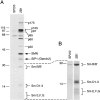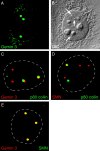Gemin3: A novel DEAD box protein that interacts with SMN, the spinal muscular atrophy gene product, and is a component of gems
- PMID: 10601333
- PMCID: PMC2168095
- DOI: 10.1083/jcb.147.6.1181
Gemin3: A novel DEAD box protein that interacts with SMN, the spinal muscular atrophy gene product, and is a component of gems
Abstract
The survival of motor neurons (SMN) gene is the disease gene of spinal muscular atrophy (SMA), a common motor neuron degenerative disease. The SMN protein is part of a complex containing several proteins, of which one, SIP1 (SMN interacting protein 1), has been characterized so far. The SMN complex is found in both the cytoplasm and in the nucleus, where it is concentrated in bodies called gems. In the cytoplasm, SMN and SIP1 interact with the Sm core proteins of spliceosomal small nuclear ribonucleoproteins (snRNPs), and they play a critical role in snRNP assembly. In the nucleus, SMN is required for pre-mRNA splicing, likely by serving in the regeneration of snRNPs. Here, we report the identification of another component of the SMN complex, a novel DEAD box putative RNA helicase, named Gemin3. Gemin3 interacts directly with SMN, as well as with SmB, SmD2, and SmD3. Immunolocalization studies using mAbs to Gemin3 show that it colocalizes with SMN in gems. Gemin3 binds SMN via its unique COOH-terminal domain, and SMN mutations found in some SMA patients strongly reduce this interaction. The presence of a DEAD box motif in Gemin3 suggests that it may provide the catalytic activity that plays a critical role in the function of the SMN complex on RNPs.
Figures




References
-
- Bertrandy S., Burlet P., Clermont O., Huber C., Fondrat C., Thierry-Mieg D., Munnich A., Lefebvre S. The RNA-binding properties of SMNdeletion analysis of the zebrafish orthologue defines domains conserved in evolution. Hum. Mol. Genet. 1999;8:775–782. - PubMed
-
- Brzustowicz L.M., Lehner T., Castilla L., Penchaszadeh G., Wilhelmsen G., Daniels R., Davies K., Leppert M., Ziter F., Wood D. Genetic mapping of chronic childhood-onset spinal muscular atrophy to chromosome 5q11.2-13.3. Nature. 1990;344:540–541. - PubMed
Publication types
MeSH terms
Substances
Associated data
- Actions
LinkOut - more resources
Full Text Sources
Other Literature Sources
Medical
Molecular Biology Databases
Research Materials

